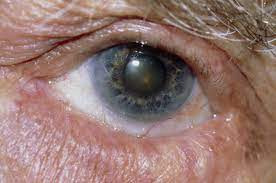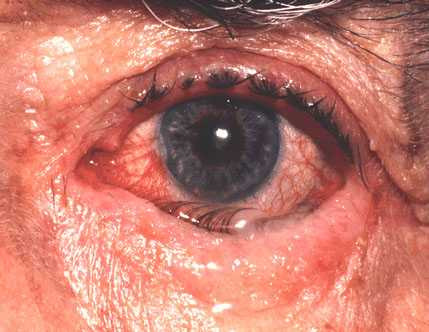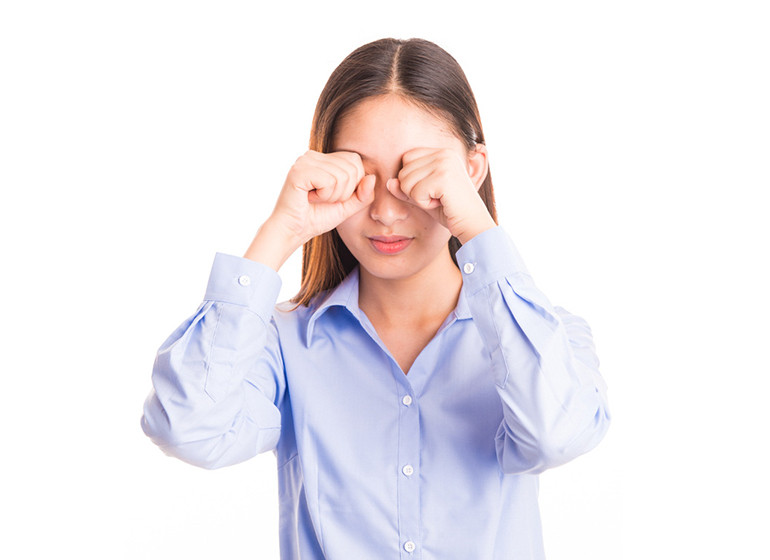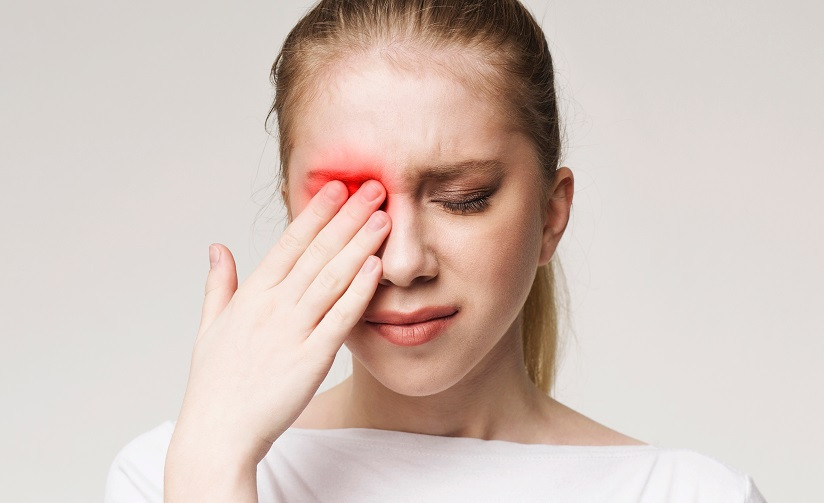Definisi
Entropion adalah pelipatan kelopak mata ke arah dalam, sehingga struktur dan kelenjar pada kelopak tersebut mengarah ke permukaan bola mata. Entropion merupakan salah satu bentuk kelainan posisi kelopak mata. Angka kejadian entropion meningkat terutama setelah usia 60 tahun, sekitar 0,9% pada usia 60-69 tahun, 2,1% pada usia 70-79 tahun, serta 7,6% di atas usia 80 tahun. Selain itu, entropion lebih banyak terjadi pada kedua mata dibandingkan dengan satu mata saja.
Penyebab
Entropion dapat disebabkan oleh beberapa penyebab. Penyebab pertama adalah hilangnya kekuatan otot penyangga kelopak mata. Kehilangan otot ini menyebabkan kecenderungan ujung kelopak berputar ke arah dalam. Hal ini merupakan penyebab tersering entropion pada lansia. Selain itu, entropion dapat disebabkan oleh bekas luka atau operasi sebelumnya. Bekas luka tersebut terjadi pada kulit kelopak mata, dan dapat berupa trauma kimia, luka bakar, trauma lainnya, atau pembedahan. Luka tersebut pulih, namun menyisakan jaringan parut yang membuat kelopak mata menjadi lebih kaku.
Selain itu, entropion dapat disebabkan oleh infeksi trakoma, yaitu infeksi oleh bakteri Chlamydia trachomatis. Infeksi ini banyak terjadi pada negara-negara berkembang di area Asia, Afrika, Timur Tengah, serta Kepulauan Pasifik. Infeksi ini dapat menyisakan bekas luka pada kelopak mata bagian dalam sehingga menyebabkan entropion dan bahkan kebutaan. Peradangan selain infeksi, misalnya disebabkan oleh mata kering, dapat mengiritasi mata, sehingga memicu penderita untuk mengucek mata atau menutupnya rapat-rapat. Hal ini dapat menyebabkan kekakuan otot kelopak mata secara akut sehingga kelopak mata tampak melekuk ke dalam.
Penyebab lainnya yang jarang terjadi adalah akibat bawaan lahir. Entropion yang terjadi akibat bawaan lahir biasanya terjadi akibat adanya lipatan kulit yang berlebih sehingga kelopak mata terlipat ke dalam.
Faktor Risiko
Faktor risiko entropion adalah usia, riwayat trauma, dan infeksi. Semakin tua usia, semakin tinggi risiko seseorang mengalami entropion. Hal ini terjadi karena kekuatan otot dan susunan jaringan pada kelopak mata melemah seiring dengan penuaan. Selain itu, riwayat trauma dapat menjadi faktor risiko, terutama trauma yang menyisakan bekas luka, misalnya luka bakar. Penyembuhan bekas luka tersebut tidak terjadi sempurna, sehingga kulit sehat digantikan oleh jaringan parut yang membuat kelopak mata menjadi semakin kaku. Sementara itu, infeksi yang berkaitan dengan entropion adalah infeksi trakoma.
Gejala
Orang yang memiliki entropion biasanya mengeluhkan adanya sensasi benda asing pada mata (mata terasa mengganjal), serta mata merah dan berair. Tidak hanya itu, gejala lainnya yang dapat terjadi adalah adanya peningkatan sensitivitas terhadap cahaya terang dan angin. Selain gejala-gejala ini, pasien dapat mengalami entropion bersamaan dengan sindroma mata kering.
Diagnosis
Dalam mendiagnosis entropion, dokter dapat menanyakan terlebih dahulu riwayat Anda, seperti riwayat terjadinya luka atau trauma di daerah mata serta riwayat infeksi atau penyakit yang menyebabkan kerusakan pada kelopak mata. Kemudian, dokter akan melakukan pemeriksaan penglihatan seperti tajam penglihatan untuk mengetahui apakah ada gangguan pada penglihatan atau tidak. Setelah itu, dokter akan memeriksa mata Anda untuk menemukan apabila ada kekakuan otot pada wajah, tanda-tanda infeksi atau iritasi, serta adanya bekas luka. Dokter dapat pula membalikkan kelopak mata Anda untuk mencari adanya bekas luka atau jaringan parut yang dapat menyebabkan entropion, atau meminta Anda untuk mengedipkan mata atau menutup mata sekencang-kencangnya, untuk melihat fungsi otot kelopak mata Anda. Jika Anda memiliki riwayat trauma atau pembedahan sebelumnya, dokter dapat mengecek bekas luka serta jaringan sekitarnya.
Selain itu, dokter dapat menarik kelopak mata Anda lalu melepaskannya untuk mengetahui kelenturannya. Normalnya, kelopak mata Anda akan kembali tanpa berkedip. Namun, jika kelenturan kelopak mata menurun, mungkin Anda perlu berkedip untuk mengembalikannya seperti semula. Jika penarikan kelopak mata itu sendiri sulit, ada kemungkinan entropion disebabkan oleh adanya jaringan parut akibat trauma atau pembedahan sebelumnya.
Selain pemeriksaan pada kelopak mata, dokter akan mengamati letak dan arah bulu mata. Pada pasien dengan entropion, bulu mata dapat mengarah ke dalam bola mata, yang disebut sebagai trikiasis. Kondisi ini dapat menyebabkan goresan pada kornea (lapisan bening di atas selaput pelangi mata) yang selanjutnya dapat menyebabkan gangguan pada penglihatan. Selain pemeriksaan tersebut, dokter dapat menggunakan pewarna untuk mencari adanya goresan atau luka pada kornea sebagai komplikasi dari entropion.
Tata Laksana
Tata laksana entropion akan tergantung dari jenisnya. Pada entropion akibat kelemahan otot, terapi dapat dilakukan dengan atau tanpa pembedahan. Biasanya, terapi yang tidak menggunakan pembedahan dilakukan apabila pembedahan ditunda atau pasien tidak memungkinkan untuk dioperasi. Dokter dapat memberikan suntikan toksin botulinum (botox) untuk membantu menarik kelopak mata keluar, atau Anda dapat menekan kelopak mata ke arah tonjolan tulang pipi agar kelopak mata dapat mengarah keluar. Terapi pembedahan dapat dilakukan untuk menarik kelopak mata keluar dengan penjahitan. Namun, efek dari terapi ini bersifat sementara, dan Anda dapat diminta untuk kembali ke dokter untuk kontrol atau mengulang terapi.
Sementara itu, pada entropion akibat kekakuan otot, penyuntikan botox dapat menjadi pilihan terapi karena sifatnya yang melemaskan otot.
Pada entropion akibat adanya jaringan parut, Anda akan diberikan terapi tergantung penyebabnya. Jika penyebab entropion adalah penyakit-penyakit seperti Sindroma Stevens-Johnson (SSJ), pemfigoid, atau trakoma, dokter akan meresepkan obat yang diperlukan untuk menangani kondisi-kondisi tersebut. Pembedahan juga dapat dilakukan untuk menarik kelopak mata keluar, misalnya dengan penjahitan kelopak mata atau penggunaan graft (jaringan yang diambil dari bagian tubuh lain, misalnya mulut).
Komplikasi
Komplikasi dari kondisi entropion adalah adanya luka pada kornea. Hal ini dapat menyebabkan rasa nyeri yang hebat dan gangguan penglihatan. Pada derajat yang parah, dapat terjadi infeksi hingga kebutaan.
Komplikasi dapat pula terjadi setelah pembedahan entropion. Komplikasi yang paling cepat terjadi adalah adanya perdarahan, infeksi, dan kegagalan graft. Perdarahan biasanya dapat dihentikan dengan kauterisasi atau membakar titik perdarahan. Sementara itu, infeksi dapat dicegah dengan pemberian antibiotik. Kegagalan graft dapat pula dicegah dengan menahan graft tersebut pada tempatnya.
Pembedahan entropion pada umumnya tidak menyembuhkan kondisi tersebut secara permanen, sehingga komplikasi yang paling sering muncul adalah kembalinya entropion. Selain itu, jika penarikan kelopak mata terlalu ekstrem, kondisi sebaliknya dapat muncul, yaitu ektropion. Ektropion, kebalikan dari entropion, adalah pelipatan kelopak mata keluar.
Pencegahan
Entropion pada umumnya tidak dapat dicegah, terutama apabila terjadi akibat kelemahan otot yang biasanya disebabkan akibat penuaan. Namun, penyebab entropion seperti trakoma dapat dicegah dengan menjaga kebersihan mata serta menghindari penggunaan handuk atau produk pada mata bersama dengan orang lain.
Kapan Harus ke Dokter?
Segeralah ke dokter apabila Anda mengalami gejala seperti di bawah ini:
- Mata merah
- Nyeri pada mata
- Sensitivitas terhadap cahaya
- Penurunan penglihatan
Gejala-gejala ini menunjukkan adanya masalah pada kornea, yang dapat menjadi komplikasi dari entropion.
Anda juga dapat ke dokter apabila ada rasa mengganjal di mata yang sulit hilang, atau melihat adanya bulu mata yang tumbuh ke arah dalam bola mata. Hal ini dapat terjadi sebagai akibat dari entropion, dan jika dibiarkan tanpa terapi, masalah pada kornea dapat terjadi, yang selanjutnya dapat mengakibatkan gangguan penglihatan hingga kebutaan.
Mau tahu informasi seputar penyakit lainnya? Cek di sini, ya!
- dr Ayu Munawaroh, MKK
DeBacker, C. (2019). Entropion: Background, Pathophysiology, Epidemiology. Retrieved 4 November 2021, from https://emedicine.medscape.com/article/1212456-overview#showall.
Entropion - Symptoms and causes. (2021). Retrieved 4 November 2021, from https://www.mayoclinic.org/diseases-conditions/entropion/symptoms-causes/syc-20351125.
Weber, A., Chundury, R., Perry, J., Del Monte, M., Goel, S., & Sundar, G. (2021). Entropion - EyeWiki. Retrieved 4 November 2021, from https://eyewiki.aao.org/Entropion.












